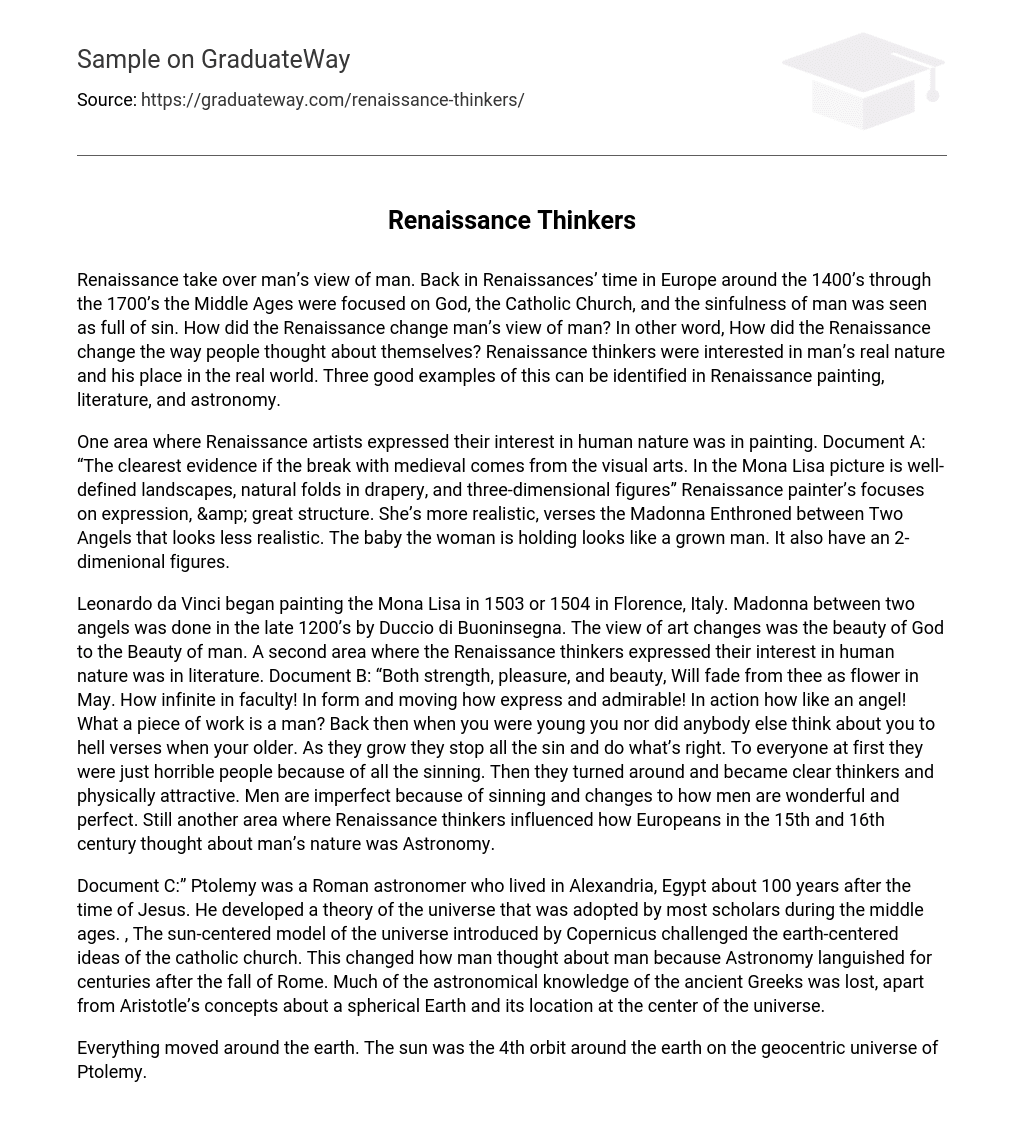The Renaissance period in Europe (around 1400s to 1700s) marked a significant change in how individuals perceived themselves. Unlike the Middle Ages, which focused on God, the Catholic Church, and humanity’s inherent sinfulness, the Renaissance brought forth a new perspective. This era challenged conventional notions and sought to understand humanity’s true nature and societal role. Three areas that exemplify this transformation are Renaissance painting, literature, and astronomy.
Renaissance artists demonstrated their fascination with human nature through their paintings. Document A suggests that the visual arts were a clear departure from medieval art. For example, the Mona Lisa portrays well-defined landscapes, realistic drapery folds, and three-dimensional figures. Renaissance painters emphasized expression and strong composition in their works. In comparison, the Madonna Enthroned between Two Angels appears less realistic, as the baby held by the woman looks like a grown man and the figures seem two-dimensional.
In Florence, Italy, Leonardo da Vinci began painting the Mona Lisa around 1503 or 1504. Duccio di Buoninsegna created Madonna between two angels in the late 1200s. The Renaissance thinkers shifted their views on art from the beauty of God to the beauty of man. They also expressed their fascination with human nature in literature. In Document B, it states, “Both strength, pleasure, and beauty will fade from thee as flower in May. How infinite in faculty! In form and moving how express and admirable! In action how like an angel! What a piece of work is a man?” When young, people rarely considered their impact on others or damnation. As they grow older, they cease sinning and strive to do what is right. Initially seen as terrible individuals due to their sinful behavior, they eventually transform into clear thinkers and physically attractive individuals. Sinning makes men imperfect, but there is also recognition of their wonderful and perfect qualities. The influence of Renaissance thinkers on European thought extended to astronomy in the 15th and 16th centuries.
Document C: Ptolemy, a Roman astronomer from Alexandria, Egypt, lived around 100 years after Jesus. He proposed a theory about the universe that was widely accepted by scholars during the medieval era. The Catholic Church’s belief in a geocentric universe was later challenged by Copernicus’ heliocentric model, which led to a change in human understanding. After the decline of the Roman Empire, astronomy experienced a period of stagnation and much of the ancient Greek astronomical knowledge was lost, except for Aristotle’s idea of a spherical Earth at the center of the cosmos.
In the geocentric universe, all celestial bodies revolved around the earth according to Ptolemy. The sun was located in the fourth orbit in this model. However, Copernicus proposed a heliocentric universe with the sun at its center. This revolutionary theory led people to reflect on their position in space. During the Renaissance era, there were changes in perspectives on human nature that could be seen in various fields like Art, Literature, and Astronomy. As a result, a new understanding of human nature started to emerge.
Contrary to the beliefs of medieval times, it is now acknowledged that man operates as a unified system governed by divine laws that can be comprehended through reason. This investigation persisted during the Early Middle Ages and saw a revival in the 12th-century Renaissance, during which scientific texts from Greek and Arabic origins were translated. Within the emerging medieval universities, scientific research advanced as these texts were scrutinized and elaborated on, leading to fresh insights into the natural world.





